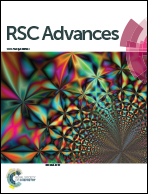Ultrafine Sb nanoparticles embedded in an amorphous carbon matrix for high-performance sodium ion anode materials
Abstract
Sodium-ion batteries (SIBs) have drawn growing interest as alternative energy-storage devices for lithium ion batteries owing to sodium's natural abundance, low cost and environmental benignity. To date, exploitation of suitable anode materials with high capacities and fast sodium ion uptake/removal for SIBs is still a great challenge. Herein, a sea-island-like SbNPs@C nanocomposite composed of Sb nanoparticles (NPs) uniformly embedded in a carbon matrix was synthesized via a facile, low cost, and high yield hydrothermal method followed by an annealing process. When used as anode materials for SIBs, the as-obtained SbNPs@C nanocomposite electrodes exhibited superior electrochemical performances (a high reversible capacity of 622 mA h g−1, 91% capacity retention over 110 cycles at 100 mA g−1 and a good rate capability of 444 mA h g−1 at 1000 mA g−1) and offered a good choice for advanced SIB anode materials.


 Please wait while we load your content...
Please wait while we load your content...